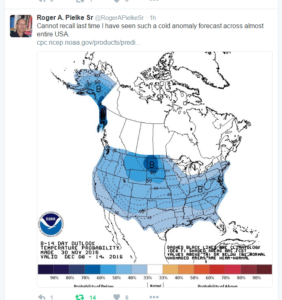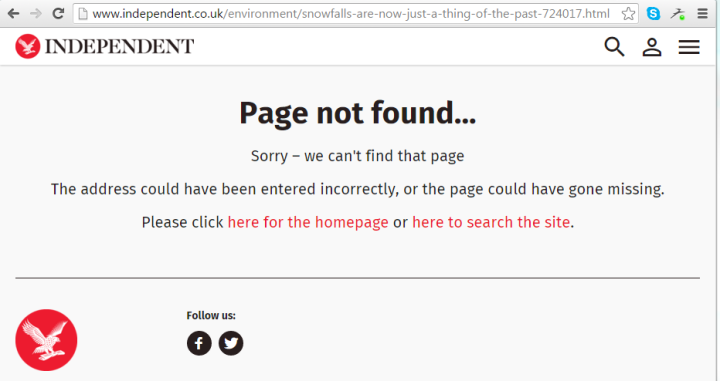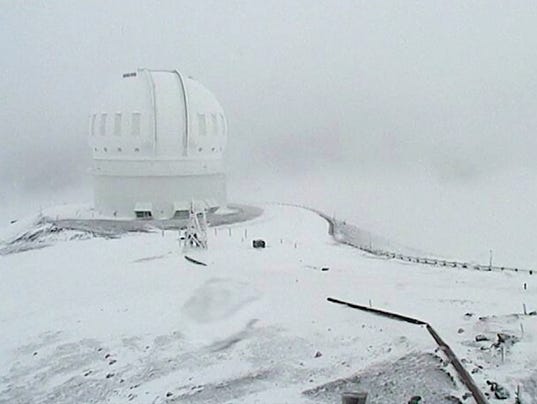- Joined
- Apr 1, 2005
- Messages
- 10,304
- Reaction score
- 6,260
BBC obviously in cahoots with NASA:
2016 'very likely' to be world's warmest year
2016 'very likely' to be world's warmest year
Freeman Dyson on climate change
An Obama supporter who describes himself as "100 per cent Democrat," Dyson says he is disappointed that the President "chose the wrong side." Increasing CO2 in the atmosphere does more good than harm, he argues, and humanity doesn't face an existential crisis. Climate change, he tells us, "is not a scientific mystery but a human mystery. How does it happen that a whole generation of scientific experts is blind to obvious facts?"
You're wasting your time.
Logic won't help you here.
Nor will reason.
Even common sense is probably not worth citing.


You're wasting your time.
Logic won't help you here.
Nor will reason.
Even common sense is probably not worth citing.


Priceless.




Hawaii expected to get 3 feet of snow. You read that right.

Snow on the peaks is not uncommon in the colder months of the year, though deep snow is rare.
“We’ll probably see three to five snow events a year during the cold season. Some years we might not get any, some years we might get more,” said Foster.
In a recent investigation published in the scientific journal Nature, scientists have explored the influence of global warming on soil carbon stocks located in the earth’s soil, which is still unclear to the scientific community.
Soil carbon stocks have a role to play in climate change because of the many biological processes of organisms living in the soil. Plants, microbes, and animals that live in the soil require exchange of carbon with the atmosphere, resulting in either sequestration of carbon through processes such as photosynthesis or liberation of carbon through processes such as decay. Scientists believe that the rate of these processes could be accelerated by global warming.
In the most recent investigation, scientists compiled a global database of soil carbon stock responses to global warming using worldwide climate change experiments. The soil samples used in the analysis were collected from 49 climate change experiments spanning six biomes in North America, Europe, and Asia. The team focused on soil samples collected within the top 10 cm of soil, which contains the greatest proportion of biologically active soil carbon.
Soil carbon stocks were compared with warmed and ambient control plots to understand the influence of temperature on carbon liberation. From these experiments, the team was able to understand the net result of long-term change in soil carbon exchange due to climate warming. It was also able to spatially map the temperature sensitivity of soil carbon stocks at a global scale.
The researchers found that the impact of warming on soil carbon stocks varied across sites. But they were able to predict the direction and magnitude of the changes, which were related to the size of the standing soil carbon stocks and the extent and duration of warming. They found that substantial losses occurred in high latitude areas.
The team took its analysis a step further by extrapolating the carbon stocks' empirical relationship to the global scale. In doing so, the scientists were able to provide estimates of the sensitivity of soil carbon exchange to global warming that can inform top climate change modeling, such as the earth system model projections.
According to their empirical relationship, global soil carbon stocks are going to fall with warming. Meaning, more carbon is going to be liberated into the atmosphere. For one degree of warming, the team predicts a fall by 30 ± 30 petagrams of carbon to 203 ± 161 petagrams of carbon in upper soil horizons. These values are dependent on the rate at which the effects of warming occur.
Assuming the response of soil carbon to warming will occur within a year and no mitigating actions against climate change occur (business as usual climate scenario), upper soil horizons would liberate 55 ± 50 petagrams of carbon into the atmosphere by 2050. This amount of carbon liberation is roughly 12-17 percent of the already expected anthropogenic emissions over the period. Regardless of the scenario, the global soil carbon response consistently exhibits increased liberation.
Together, this analysis strongly supports the assertion that global warming will stimulate liberation of soil carbon stocks into the atmosphere, creating a positive-feedback mechanism that could further accelerate climate change. This analysis should be taken into consideration when developing future climate change models to best predict the outcomes and to develop the most effective mitigation plans.
Peer-Reviewed Survey Finds Majority Of Scientists Skeptical Of Global Warming Crisis
Don’t look now, but maybe a scientific consensus exists concerning global warming after all. Only 36 percent of geoscientists and engineers believe that humans are creating a global warming crisis, according to a survey reported in the peer-reviewed Organization Studies. By contrast, a strong majority of the 1,077 respondents believe that nature is the primary cause of recent global warming and/or that future global warming will not be a very serious problem.
Looking at more recent events, it keeps getting harder and harder to deny that for whatever reason, the Earth is warming, and at a pace quicker than can be found in historic evidence.

